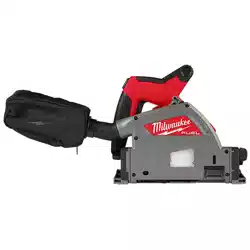Loading ...
Loading ...
Loading ...

12
3. Position your arms and body to resist Kickback.
4. To start the saw, push the lock-o button down,
then pull the trigger. Allow the motor to reach full
speed before beginning cut.
5. Slowly plunge the saw until preset depth is
reached.
6. Move the saw forward through the workpiece while
following the cut line.
7. While cutting, keep the shoe flat against the
workpiece and maintain a rm grip. Do not force
the saw through the workpiece. Forcing a saw can
cause Kickback.
8. If making a partial cut, restarting mid-cut or cor-
recting direction, allow the blade to come to a
complete stop. To resume cutting, center the blade
in the kerf, back the saw away from cutting edge
a few inches, push the lock-o button down, pull
the trigger and re-enter the cut slowly.
9. If the saw binds and stalls, maintain a rm grip
and release the trigger immediately. Hold the saw
motionless in the workpiece until the blade comes
to a complete stop.
10. After nishing a cut, release the trigger, be sure
the blade comes to a complete stop and return the
front handle to its upright position before setting
the saw down.
Electric Brake
The electric brake engages when the trigger is
released, causing the blade to stop and allowing
you to proceed with your work. Generally, the saw
blade stops within two seconds. However, there
may be a delay between the time you release the
trigger and when the brake engages. Occasion-
ally the brake may miss completely. If the brake
misses frequently, the saw needs servicing by
an authorized MILWAUKEE service facility. The
brake is not a substitute for the guard, and you
must always wait for the blade to stop completely
before removing the saw from the workpiece.
Troubleshooting
If the blade does not follow a straight line:
• Teeth are dull. This is caused by hitting a hard object
such as a nail or stone, dulling teeth on one side. The
blade tends to cut to the side with the sharpest teeth.
• Shoe is out of line or bent
• Blade is bent
If the blade binds, smokes or turns blue from friction:
• Blade is dull
• Blade is on backwards
• Blade is bent
• Blade is dirty
• Workpiece is not properly supported
• Incorrect blade is being used
• Battery charge is low
APPLICATIONS
Cutting Large Panels
Large panels and long boards sag or bend if they are
not correctly supported. If you attempt to cut without
leveling and properly supporting the workpiece, the
blade will tend to bind, causing Kickback.
Support large panels. Be sure to set the depth of the
cut so that you only cut through the workpiece, not
through the supports.
Cross-Cutting Wood
Cross-cutting is cutting across the grain. Select the
proper blade for your job. Advance the saw slowly
to avoid splintering the wood.
Plunge Cutting
WARNING
To reduce the risk of electric shock,
check work area for hidden pipes
and wires before making plunge cuts.
Plunge cuts are made in the middle of the workpiece
when it can not be cut from an edge. To maintain
control of the saw during plunge cutting, keep both
hands on the saw.
1. Draw a cutting line.
2. Line up the sight line on the front and back of
tool with your cutting line. The sight line indi-
cates where the blade is cutting.
Tool with a guide rail:
Position (A) indicates the inside edge of the cut
at every bevel angle.
Tool without a guide rail:
Position (A) indicates the inside edge of the cut
at 0º bevel.
Position (B) indicates the inside edge of the cut
at 45º bevel.
A B
Loading ...
Loading ...
Loading ...
